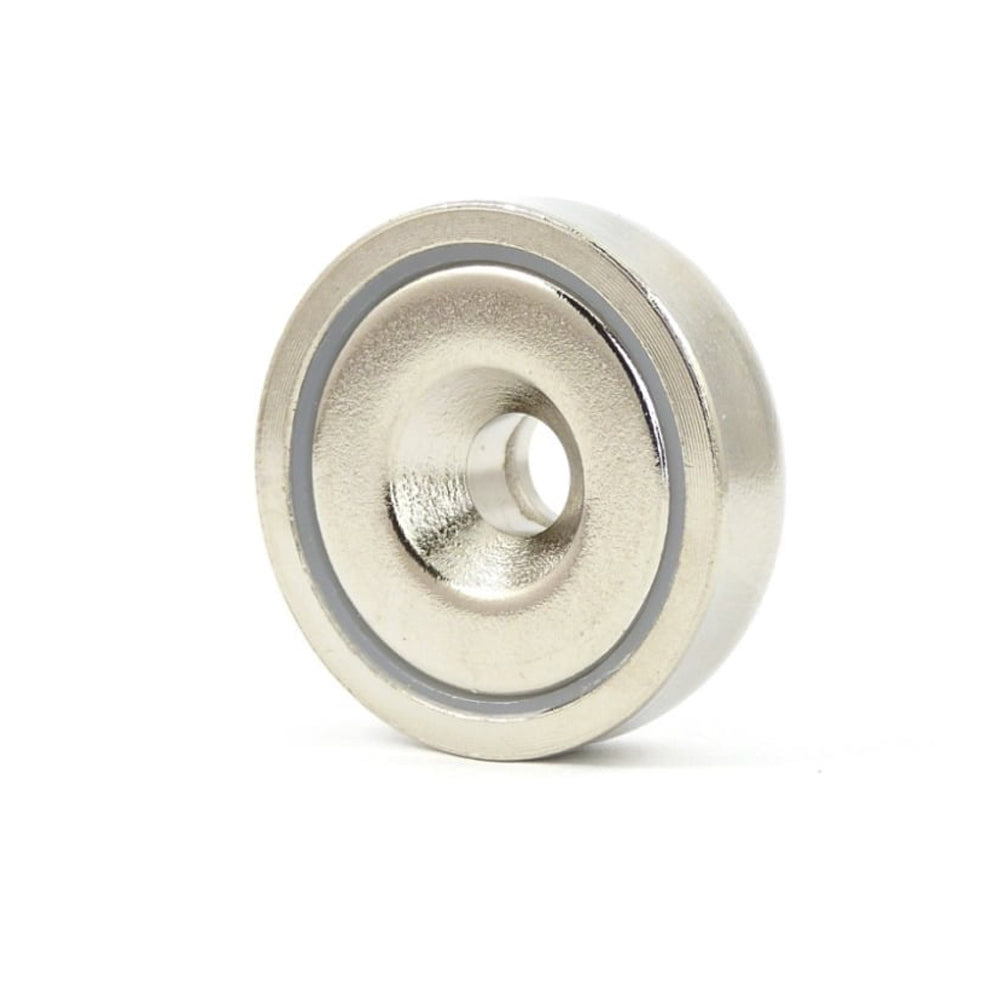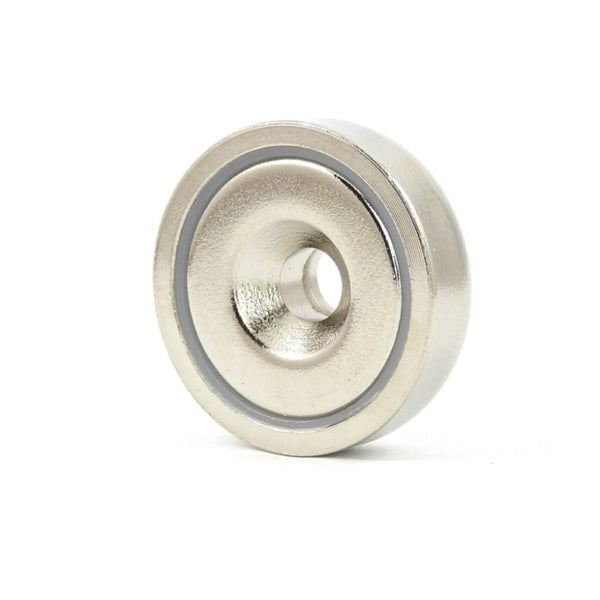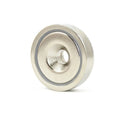Neodymium Countersunk Pot Magnet - 60mm x 15mm
Product code: AMFYPA60






Prices are GST Incl.
Request a Quote for Bulk OrdersAustralia's Leading Supplier
Shipping Worldwide*
30 Day Returns
Same Day Dispatch*

Magnetic Product Description:
This rare earth pot magnet has a diameter of 60mm, a countersunk hole diameter of 8.5mm and a thickness of 15mm. It has a pull force of 112kg and a weight of 252 grams. It is identified by the AMF magnet part number AMFYPA60.
Uses for our rare earth countersunk pot magnets:
With a pull force of 112 kg these countersunk pot magnets 60mmx15mm are not for the faint hearted. Lifting, holding and securing heavy objects is a serious business and can be dangerous if trouble strikes.
Machinery and equipment allied with these magnets, the void of which allows for the attachment of a hook or eyelet, reduce the risks in engaging, lifting, carrying, lowering and releasing heavy objects. Magnetic engagement allows a secure hold and release at a pre-determined pull force, necessary for industrial scale applications.
Magnets are a different kind of fastening system, but surprisingly cost effective. Steel, stone, concrete and solid timber, just some of the materials married to magnets of all kinds, for fixing, holding, releasing, and re-engaging as the preferred connective tissue.
Magnetic force and engagement provides more security before, during and after the lift than chains, slings and ropes. When the going gets tough, the tough get going. When the going gets heavy, lighten the load with magnetic force. Allied with cranes, hoists and winches, these, 60mmx15mm countersunk pot magnets, sometimes with hooks or eyelets attached, also find happy homes in hospitals, home care aids and aged care facilities.
This strong rare earth pot magnet is often used for industrial applications. This neodymium pot is ideal for manufacturing exhibition stands and custom furniture. It has a high strength magnet in a mild-steel nickel-coated pot with a countersunk hole.
| SKU | DØ | D1Ø | D2Ø | H | Pull Force (kg) | Weight (g) |
| AMFYPA10 | 10 | 3.7 | 7.4 | 4.5 | 1.4 | 2.2 |
| AMFYPA16 | 16 | 3.5 | 6.5 | 5 | 5 | 7 |
| AMFYPA20 | 20 | 4.5 | 8.5 | 7 | 6 | 13 |
| AMFYPA25 | 25 | 5.5 | 10.4 | 8 | 14 | 23 |
| AMFYPA25SLIM | 25 | 5.5 | 10.4 | 6.65 | 12 | 20 |
| AMFYPA32 | 32 | 5.5 | 10.4 | 8 | 25 | 39 |
| AMFYPA32SLIM | 32 | 5.5 | 10.4 | 6.65 | 22 | 34 |
| AMFYPA36 | 36 | 6.5 | 12 | 9 | 29 | 52 |
| AMFYPA36SLIM | 36 | 6.5 | 12 | 6.7 | 25 | 44 |
| AMFYPA42 | 42 | 6.5 | 12 | 7.9 | 58 | 65 |
| AMFYPA48 | 48 | 8.5 | 16 | 11.5 | 68 | 120 |
| AMFYPA48SLIM | 48 | 8.5 | 16 | 9.35 | 56 | 100 |
| AMFYPA60 | 60 | 8.5 | 16 | 15 | 112 | 252 |
| AMFYPA75 | 75 | 10.5 | 19 | 18 | 162 | 488 |
No FAQ available

NB: Ranges are indicative for product category, please check individual products for specic values within that range.



The most common coating for Neodymium magnets is Nickel + Copper + Nickel (Ni + Cu + Ni). This coating offers the magnet relatively good protection from corrosion and passive applications. If the magnet will be exposed to moisture or liquid then consider the use of an organic coating such as Epoxy. A hard wearing coating, Epoxy is suited to applications where the magnet will come under some friction or knocking.

Magnets are readily available in Blocks, Discs, Cylinders & Rings. AMF Magnetics specializes in the supply of short-run prototype magnets including Arc Segments, various magnetic orientations etc. If you need a magnet size that we don't carry in stock, submit a Design-a-Magnet enquiry for a quote on your custom magnet design.

Neodymium magnets are offered in several different grades. The first section N30-54 has an operating temperature of up to 80 degrees. Most of our stock only goes up to N38. The second section, denoted with the "M" prefix after the grade has an operating temperature 100 degrees. After this the grades are "H", "SH", "UH" & "EH". In order for the magnet to withstand a higher operating temperature, during production more of the raw material PrNd is incorporated as these elements have a naturally occurring resistance to high temperatures.

Magnetic Product Description:
This rare earth pot magnet has a diameter of 60mm, a countersunk hole diameter of 8.5mm and a thickness of 15mm. It has a pull force of 112kg and a weight of 252 grams. It is identified by the AMF magnet part number AMFYPA60.
Uses for our rare earth countersunk pot magnets:
With a pull force of 112 kg these countersunk pot magnets 60mmx15mm are not for the faint hearted. Lifting, holding and securing heavy objects is a serious business and can be dangerous if trouble strikes.
Machinery and equipment allied with these magnets, the void of which allows for the attachment of a hook or eyelet, reduce the risks in engaging, lifting, carrying, lowering and releasing heavy objects. Magnetic engagement allows a secure hold and release at a pre-determined pull force, necessary for industrial scale applications.
Magnets are a different kind of fastening system, but surprisingly cost effective. Steel, stone, concrete and solid timber, just some of the materials married to magnets of all kinds, for fixing, holding, releasing, and re-engaging as the preferred connective tissue.
Magnetic force and engagement provides more security before, during and after the lift than chains, slings and ropes. When the going gets tough, the tough get going. When the going gets heavy, lighten the load with magnetic force. Allied with cranes, hoists and winches, these, 60mmx15mm countersunk pot magnets, sometimes with hooks or eyelets attached, also find happy homes in hospitals, home care aids and aged care facilities.
This strong rare earth pot magnet is often used for industrial applications. This neodymium pot is ideal for manufacturing exhibition stands and custom furniture. It has a high strength magnet in a mild-steel nickel-coated pot with a countersunk hole.
| SKU | DØ | D1Ø | D2Ø | H | Pull Force (kg) | Weight (g) |
| AMFYPA10 | 10 | 3.7 | 7.4 | 4.5 | 1.4 | 2.2 |
| AMFYPA16 | 16 | 3.5 | 6.5 | 5 | 5 | 7 |
| AMFYPA20 | 20 | 4.5 | 8.5 | 7 | 6 | 13 |
| AMFYPA25 | 25 | 5.5 | 10.4 | 8 | 14 | 23 |
| AMFYPA25SLIM | 25 | 5.5 | 10.4 | 6.65 | 12 | 20 |
| AMFYPA32 | 32 | 5.5 | 10.4 | 8 | 25 | 39 |
| AMFYPA32SLIM | 32 | 5.5 | 10.4 | 6.65 | 22 | 34 |
| AMFYPA36 | 36 | 6.5 | 12 | 9 | 29 | 52 |
| AMFYPA36SLIM | 36 | 6.5 | 12 | 6.7 | 25 | 44 |
| AMFYPA42 | 42 | 6.5 | 12 | 7.9 | 58 | 65 |
| AMFYPA48 | 48 | 8.5 | 16 | 11.5 | 68 | 120 |
| AMFYPA48SLIM | 48 | 8.5 | 16 | 9.35 | 56 | 100 |
| AMFYPA60 | 60 | 8.5 | 16 | 15 | 112 | 252 |
| AMFYPA75 | 75 | 10.5 | 19 | 18 | 162 | 488 |
No FAQ available

NB: Ranges are indicative for product category, please check individual products for specic values within that range.



The most common coating for Neodymium magnets is Nickel + Copper + Nickel (Ni + Cu + Ni). This coating offers the magnet relatively good protection from corrosion and passive applications. If the magnet will be exposed to moisture or liquid then consider the use of an organic coating such as Epoxy. A hard wearing coating, Epoxy is suited to applications where the magnet will come under some friction or knocking.

Magnets are readily available in Blocks, Discs, Cylinders & Rings. AMF Magnetics specializes in the supply of short-run prototype magnets including Arc Segments, various magnetic orientations etc. If you need a magnet size that we don't carry in stock, submit a Design-a-Magnet enquiry for a quote on your custom magnet design.

Neodymium magnets are offered in several different grades. The first section N30-54 has an operating temperature of up to 80 degrees. Most of our stock only goes up to N38. The second section, denoted with the "M" prefix after the grade has an operating temperature 100 degrees. After this the grades are "H", "SH", "UH" & "EH". In order for the magnet to withstand a higher operating temperature, during production more of the raw material PrNd is incorporated as these elements have a naturally occurring resistance to high temperatures.



















